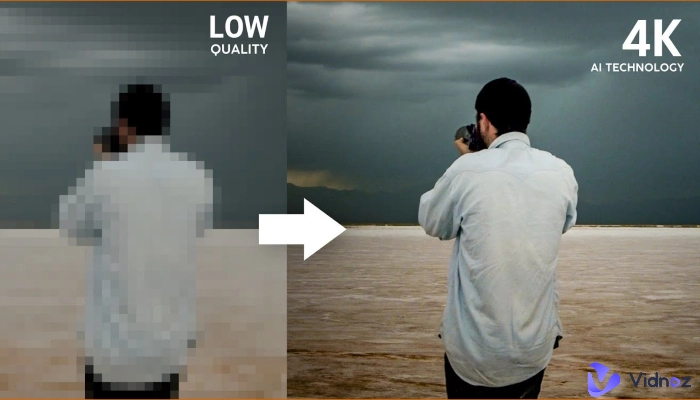In a world where every pixel counts, the quest for incredible image quality is more relevant than ever. With the rise of 8k resolution, photography enthusiasts and professionals alike are seeking new ways to elevate their images beyond traditional limits. Imagine transforming an ordinary photo into a stunning visual feast that captivates viewers with jaw-dropping detail and clarity. Whether you’re looking to enhance your personal collection or impress clients with breathtaking visuals, understanding how to effectively enhance photos to 8k can open up a realm of possibilities in high-resolution photography. Let’s dive into this exciting journey of enhancement and discover how you can harness the power of 8k technology!
Understanding the Concept of 8k Resolution
8k resolution refers to a display or image with a width of approximately 8,000 pixels. This staggering pixel count translates into four times the detail of 4k and sixteen times that of standard full HD.
The term “resolution” signifies how many pixels make up an image. More pixels mean sharper images and finer details. In practical terms, this means vibrant colors and crystal-clear textures that draw viewers in.
Originally developed for large screens, 8k is now becoming increasingly accessible across various devices. From high-end televisions to professional monitors, its adoption is on the rise.
Photographers are eager to embrace this technology as it allows them to showcase their work at unprecedented levels of clarity. Whether it’s landscapes or portraits, every nuance can be appreciated like never before with stunning precision.
Benefits of Enhancing Photos to 8k
Enhancing photos to 8k opens up a world of visual possibilities. The sheer detail in an 8k image is astonishing, allowing viewers to appreciate textures and colors like never before.
Fine art, landscapes, or portraits gain depth when upgraded to this resolution. It transforms ordinary images into stunning works that captivate audiences.
For professionals in photography or marketing, 8k enhances the overall impact of their portfolios. Clients are drawn to crisp visuals that convey quality and precision.
Moreover, displaying content on modern screens often requires high resolution for optimal performance. Upgrading ensures your work stands out across platforms.
As technology advances, so do viewer expectations. Meeting these demands with sharp imagery can elevate personal projects or brand identity significantly. Enhanced photos resonate more profoundly with audiences hungry for clarity and beauty.
Factors to Consider Before Enhancing Photos to 8k
Before diving into the enhancement process, it’s crucial to assess your original photo’s quality. Consider factors like resolution, clarity, and existing details. A low-quality image may not benefit much from upscaling.
Evaluate the subject matter of your photos as well. Highly detailed images such as landscapes or architecture often translate better to 8K than portraits or busy scenes with lots of motion.
Storage space is another key factor. High-resolution files take up significantly more room on your devices. Ensure you have adequate storage solutions in place before proceeding with enhancements.
Think about the intended use for these enhanced images. Whether for professional displays or personal projects will dictate how much effort and resources you invest in achieving that stunning 8K quality.
Techniques for Enhancing Photos to 8k
When it comes to enhancing photos to 8k, several techniques can make a significant difference. Start by utilizing interpolation methods. These algorithms add pixels between existing ones, resulting in smoother transitions and sharper images.
Another effective technique is noise reduction. High-resolution images often expose noise more prominently. Using software that specializes in denoising will help maintain clarity while removing unwanted artifacts.
Sharpening plays a crucial role too. Carefully applying sharpening filters enhances details without compromising the overall quality of the image.
Consider adjusting color profiles as well. Enhancing saturation and contrast can breathe life into your photo, making colors pop at higher resolutions.
Experiment with upscaling tools powered by artificial intelligence. These advanced solutions leverage machine learning to predict pixel placement intelligently, providing stunning results that traditional methods can’t match.
Recommended Software and Tools for Enhancing Photos to 8k
When it comes to enhancing photos to 8k, having the right software makes all the difference. Adobe Photoshop remains a top choice for professionals. Its powerful features allow for precise editing and upscaling without losing detail.
Another great option is Topaz Gigapixel AI. This tool uses artificial intelligence to intelligently enlarge images while preserving textures and sharpness. It’s especially effective for photographers who want fast results without compromising quality.
For those seeking a more user-friendly experience, Luminar AI offers an intuitive interface paired with impressive enhancement capabilities.
Don’t overlook free options like GIMP or Paint.
NET either; they provide robust tools that can help elevate your images at no cost. Choosing the right software will depend on your specific needs and comfort level with technology, but there are plenty of excellent choices available today.
Tips for Maintaining Quality in the Enhancement Process
Maintaining quality during the enhancement process is crucial. Start with high-resolution images as your base. The better the original, the more detail you can work with.
Always use lossless formats when saving your files. This ensures no data is lost in compression, preserving image integrity throughout editing.
Consider using non-destructive editing techniques. Programs like Adobe Photoshop allow you to make adjustments without altering the original file directly, enabling flexibility for future edits.
Regularly zoom in while enhancing to spot imperfections that might not be visible at a standard view. Fine-tuning details adds depth and clarity.
Calibrate your monitor regularly for accurate color representation. This helps ensure that any enhancements made will look consistent across different devices and platforms.
Conclusion: The Future of High-Resolution Photography
The evolution of photography is moving towards ever higher resolutions. As we embrace the capabilities of 8k and beyond, the demand for stunning visuals continues to rise. Enhancing photos to 8k not only improves clarity but also opens up new creative opportunities.
With advances in technology, tools are becoming more accessible and user-friendly. Photographers at all levels can experiment with high-resolution enhancements without needing extensive technical knowledge.
As we look ahead, high-resolution photography will likely become standard across various platforms—from personal use to professional projects. The ability to enhance images seamlessly will redefine how we capture moments and tell stories through visuals.
Embracing this shift means staying informed about emerging trends and techniques. Those who adapt will find themselves at the forefront of a new visual era where every pixel counts.



